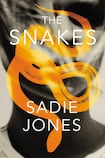
Well into The Snakes, Costa winner Sadie Jones’s first novel in a contemporary setting, one of the protagonists observes celebrations for a dead family member: “It was a rich crowd; not the clothes or face work [. . .] The richness was far stronger than that. It was in the people themselves. She wondered what level of wealth it took, to rearrange the molecules.” How wealth rearranges the molecules of a self, and of a relationship, is the subject of this literary thriller.
Bea Adamson is a conscientious, unassuming psychotherapist; Dan Durrant is a good-looking, artistic estate agent who wants to be a painter. Both have the same politics and outlook, but Bea is white and from a wealthy background she would rather disown. Dan is mixed-race, from a single-parent south London family and, at this point, only has a “notional” idea that Bea’s family are “well off”. They are in fact super-rich, her father having built his property empire through exploitation. Exposure to Bea’s family is something from which she has tried to insulate her husband, but which will change their relationship on every level: how they think about each other, how they choose to live, and whether they live.
Having decided to take time off work to travel Europe, the couple visit Bea’s brother Alex: the only one of her family she can stand. He is a recovering drug addict and current alcoholic; a consummate dropout who is now failing to renovate a hotel in rural Burgundy with an attic full of snakes. When Bea’s parents, Griff and Liv, arrive, the holiday is spoilt. What at first appears to be a tragic road accident involving a family member might be something more sinister when the local gendarmerie get involved, with a racially motivated interest in Dan. But there has always been something more sinister about the Adamsons. Bea has distanced herself from her family and their money because of abuse inflicted on Alex as a young boy.
The real snakes
The whodunnit and procedural elements of the book which stem from the mysterious car crash are tense and well-realised. But when not affecting elements of the central relationship – the police’s assumptions that Dan is with the less attractive Bea for her money; the memories of indiscriminate arrests he suffered as a teenager because of his skin colour – these elements can detract from it. Jones has a way with the unworthy thoughts that follow even the most well-meaning and mild of characters. These are the real snakes of her story: the “pride” Dan feels when he is protected by Adamson money; the curiosity he can’t help feeling about googling the news of the central Adamson tragedy to see “how other people saw his wife’s family, and if there were any pictures of Bea”. This is all excellent. His awakening to the implications of money and status brings out unappealing qualities in himself, but also makes him aware of them in Bea: “Even her accent had come up a notch, dropping the everywoman patina she used for work – and, he thought, for the first time, maybe for him.”
Power balance
Reading and enjoying this well-written thriller, there is nonetheless a feeling that a stealthier, less dangerous novel wants to emerge, shedding the skin of hot, stifling trips abroad – so rote now in fiction of every stripe – dodgy circumstances surrounding deaths, and police stations. Something focused solely on the power balance in Bea and Dan’s relationship, and the family history of abuse and mistreatment (which is addressed directly only a handful of times), culminating in Dan Durrant’s knowledge or decision, as a mixed-race man with an absentee white father, to benefit from money made by Griff “keeping the Windrush generation in his slums”. Just as, in Alan Hollinghurst’s brilliant 1988 debut The Swimming Pool Library, a rich gay protagonist must accept that his money and aristocracy come from the anti-gay “vice” purges carried out by his grandfather.
As engrossing is Bea’s struggle with her money, from being constantly aware of and apologetic for her privilege, to the ambiguous idea of its ethical use. This could have been further explored had not so much literary oxygen been taken up with the whodunit, which is not especially surprising in its denouement, and an all-consuming escalation of pace. Much tenser is seeing how Dan’s loyalties shift around members of the Adamson family, and the risk he runs of alienating Bea. It would have been a rich experience, for want of a better word, to observe a slower rearrangement of molecules on Bea’s behalf as well as Dan’s; see the way their whole selves are calibrated by money, in more texture if not more detail.










